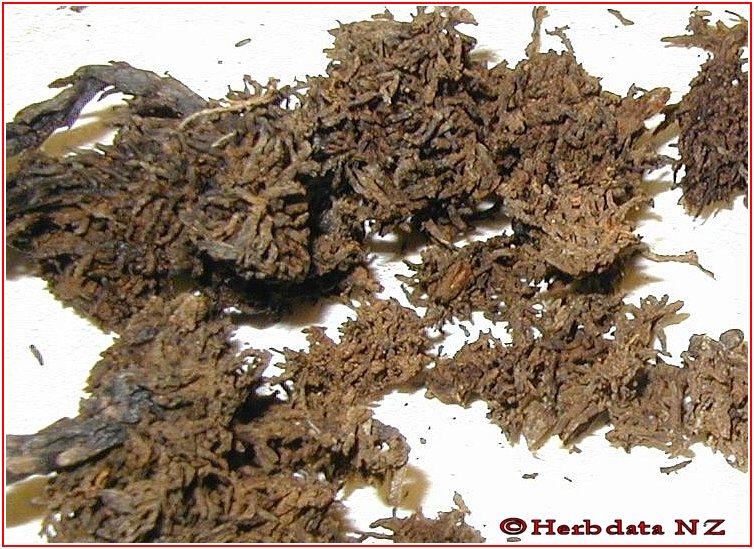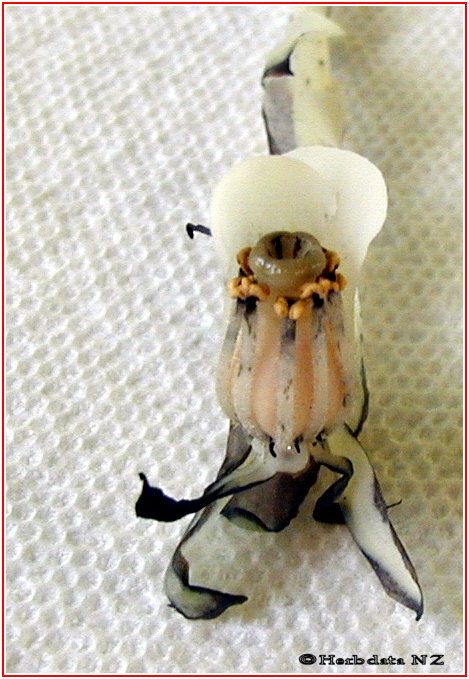

Preparation of Indian
pipe
Monotropa uniflora L.
Ivor Hughes.
The root has been determined to be the medicinal part of the plant. This of course is no more than official recognition of prior Indigenous knowledge. The image on the left is that of cleaned and dried but unprepared root. This is the drug in its crude form.
The plant including the rootstock is extremely delicate. This is evidenced by the image of the sexual organs of the plant. Within minutes of the petals being folded back, severe and spreading necrosis will be observed. Care must be taken when handling the plant and especially the root.
When the plant has died back it is freshly dug. The root appears as small tight nugget of closely intertwined roots, compacted with the adhering soil. This should be carefully washed away in running water and the root promptly dried to circa 6% moisture to prevent further oxidation damage.

If the root is not required for immediate processing it may be stored in the usual manner for crude drugs. Which should be as close to its whole form as is feasible. When required for use it may be rubbed through a 18 to 20 mesh sieve, a flour sieve will answer.
Methods of processing from root crude form are via water or diluted alcohol of the pharmacopoeia. Remember that crude plant drugs have a limited shelf life and that deterioration continues apace. Alcoholic extracts have a shelf life measured in decades as compared to the 9 months in crude form. Or a mere 12 hours as a recentium.
There are four possible routes of preparation;*
1. Extended infusion. A minimum of 30 minutes.
2. Extraction by alcohol of the pharmacopoeia.
3. Soft extract.
4. Powdered root.
*
See the Pharmageddon Herbal.Abstracted from King's
American Dispensatory.
Indian Pipe Picture
Monograph
Action, Medical Uses, and Dosage. Ice-plant root is a tonic, sedative, nervine, and antispasmodic. It has also been employed in febrile diseases, as a sedative and diaphoretic. The powder has been employed in instances of restlessness, pains, nervous irritability, etc., as a substitute for opium, without any deleterious influences. It is reputed to have cured remittent and intermittent fevers, and to be an excellent anti-periodic. In convulsions of children, epilepsy, chorea, and other spasmodic affections, its administration has been followed with prompt success; hence its common name Fit or Convulsion root. The juice of the plant, alone, or combined with rose water, has been found an excellent application to obstinate ophthalmic inflammation, to ulcers, and as an injection in gonorrhea, and inflammation and ulceration of the bladder.
Dose of the powdered root, from 1/2 to 1 drachm, 2 or 3 times a day. It has been used as a substitute for opium.
The authors of King�s American have used the term injection. This should be understood as the flooding of the external body cavities by a syringe and not by hypodermic needle. The drachm is 3.88 gram of the dried powered root. If given thrice daily that is a substantial amount being the equivalent of 1.23 ounces of fresh root. The major disadvantage of the powdered root of course is its limited shelf life and one is dependent from season to season for fresh supplies. It may be delivered as a pill made with a suitable excipient or as a cachet.
The infusion should be prepared as � ounce to the pint (15g to 500ml) and delivered as a wine glass 5 times daily with adjustments made for the normal variations of age, weight, sex etc.
Liquid extracts can made as 1:1 70%. And further reduced for the preparation of a suppository as an alternative to the injection which must be a water extract. Dose between 1 and 2 ml. thrice daily or as required.
The plant is normally wild harvested and as such the utmost respect must be shown in what is taken. The plant must be able to reproduce. The herbalist is a sensitive and not a greed driven barbarian.
Auckland NZ 2004
See Indian Pipe Monograph for more information